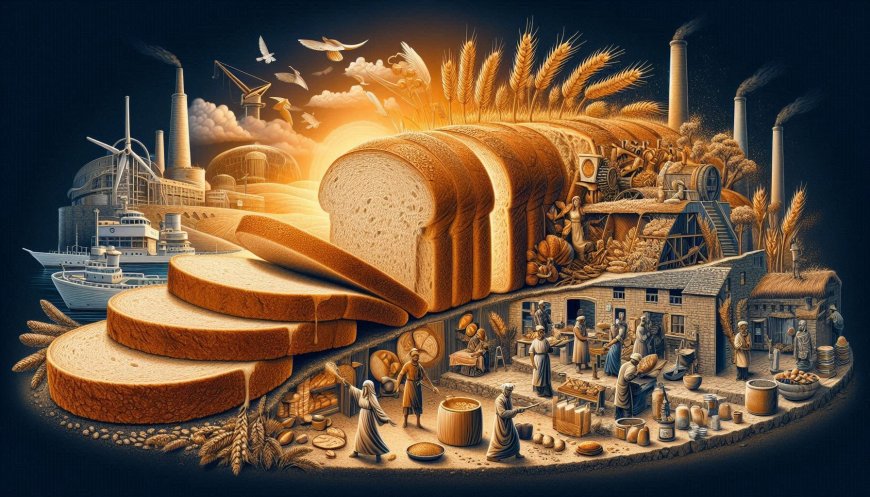The Slice of History: How Bread Changed the World
Discover the fascinating history of bread and its impact on civilization, from ancient grain farming to modern industrial baking. Explore how bread has shaped cultures, economies, and societies throughout the ages.

We’ve all heard the phrase, “the best thing since sliced bread,” tossed around in conversation, but have you ever wondered where it came from? This everyday expression has roots in a quiet town in Missouri, where a simple invention in the late 1920s transformed how the world eats, giving rise to one of the greatest conveniences of modern life: pre-sliced bread.
It all began in 1928, in the small town of Chillicothe, where the Chillicothe Baking Company took a leap of faith on a revolutionary idea. Otto Frederick Rohwedder, a determined inventor, had just perfected a machine that sliced bread into uniform pieces and wrapped it for freshness. The world had never seen anything like it, and that little bakery in Missouri became the first to introduce this concept to the public. They called it “Kleen Maid Sliced Bread,” and while it might sound simple now, it was a marvel at the time.
The Birth of Sliced Bread
Before sliced bread, buying bread meant getting a whole loaf that had to be cut at home—often unevenly and with some effort. Rohwedder’s machine changed all that. With the push of a button, it cut the bread into neat, uniform slices, revolutionizing how people experienced their daily bread. Housewives and bakers alike marveled at the convenience, and suddenly, breakfast got a lot easier.
But not everyone was on board right away. Skeptics worried that pre-sliced bread would dry out too quickly, or that the slices would crumble. However, it didn’t take long for consumers to realize that the convenience far outweighed any doubts. No longer would people struggle with uneven slices or thick, unwieldy pieces that didn’t fit in their toasters. And with Rohwedder’s machine also wrapping the bread, it stayed fresher longer, dispelling fears of it going stale.
As word spread, sliced bread became an instant sensation. It was an innovation that touched everyone’s life, from making sandwiches a breeze to transforming the humble breakfast toast. Grocery stores could hardly keep it on the shelves, and it wasn’t long before pre-sliced bread became a household staple.
A Technological Marvel
Rohwedder’s bread-slicing machine was more than just a clever gadget. It was a symbol of the larger technological shifts happening in the early 20th century. America was in the midst of an industrial revolution, where machines were making everyday tasks faster, easier, and more efficient. From cars rolling off assembly lines to household appliances like refrigerators and washing machines, technology was transforming daily life.
Sliced bread was a part of that movement. It reflected a cultural shift toward convenience and progress, where machines weren’t just for factories—they were for the kitchen, too. The ability to buy pre-sliced bread was an early glimpse of how mechanization would reshape food preparation and daily living. What seemed like a small innovation was, in fact, a symbol of modernity.
The Phrase that Lasted
The success of sliced bread soon became the gold standard for innovation. In the years that followed, as new products and technologies came to market, people began to measure them against the convenience and impact of sliced bread. Hence, the phrase “the best thing since sliced bread” was born.
Today, it’s more than just an idiom—it’s a testament to how this simple idea changed the way we think about food and convenience. We may take it for granted now, but in the 1920s, this invention was nothing short of revolutionary. It showed how something as mundane as bread could be made better, faster, and easier with the right technology.
A Lasting Legacy
Nearly a century later, we rarely think twice about picking up a loaf of pre-sliced bread at the store. It’s everywhere, so ubiquitous that buying unsliced bread seems almost foreign. Yet the legacy of that innovation, the one born in a small Missouri town, continues to influence us today.
The Chillicothe Baking Company’s bold move to embrace Rohwedder’s machine is a reminder of how simple ideas can have lasting impacts on daily life. It wasn’t just about convenience—it was about how technology could improve even the most basic elements of life. The bread on our tables, cut into perfect slices, is more than just food. It’s a symbol of progress, a nod to the power of innovation, and, yes, the best thing since sliced bread.
So the next time you spread butter on a perfectly cut slice of bread, take a moment to appreciate the story behind it—a slice of history that changed the world.
What's Your Reaction?








































































































